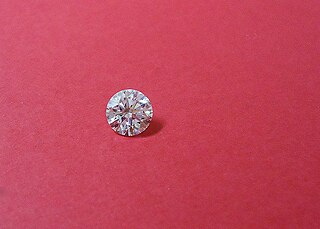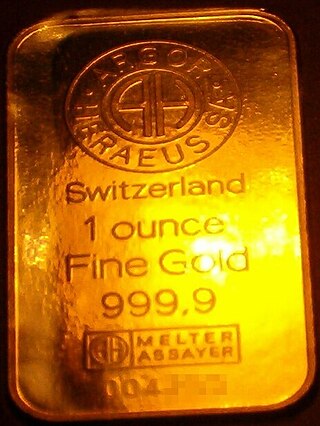
The carat (ct) is a unit of mass equal to 200 mg, which is used for measuring gemstones and pearls. The current definition, sometimes known as the metric carat, was adopted in 1907 at the Fourth General Conference on Weights and Measures, and soon afterwards in many countries around the world. The carat is divisible into 100 points of 2 mg. Other subdivisions, and slightly different mass values, have been used in the past in different locations.

The pound or pound-mass is a unit of mass used in British imperial and United States customary systems of measurement. Various definitions have been used; the most common today is the international avoirdupois pound, which is legally defined as exactly 0.45359237 kilograms, and which is divided into 16 avoirdupois ounces. The international standard symbol for the avoirdupois pound is lb; an alternative symbol is lbm, #, and ℔ or ″̶.

Troy weight is a system of units of mass that originated in 15th-century England, and is primarily used in the precious metals industry. The troy weight units are the grain, the pennyweight, the troy ounce, and the troy pound. The troy grain is equal to the grain unit of the avoirdupois system, but the troy ounce is heavier than the avoirdupois ounce, and the troy pound is lighter than the avoirdupois pound. One troy ounce equals exactly 31.1034768 grams.

A grain is a unit of measurement of mass, and in the troy weight, avoirdupois, and apothecaries' systems, equal to exactly 64.79891 milligrams. It is nominally based upon the mass of a single ideal seed of a cereal. From the Bronze Age into the Renaissance, the average masses of wheat and barley grains were part of the legal definitions of units of mass. Expressions such as "thirty-two grains of wheat, taken from the middle of the ear" appear to have been ritualistic formulas, essentially the premodern equivalent of legal boilerplate. Another source states that it was defined such that 252.458 units would balance 1 cubic inch (16 cm3) of distilled water at an ambient air-water pressure and temperature of 30 inches of mercury (100 kPa) and 62 °F (17 °C) respectively. Another book states that Captain Henry Kater, of the British Standards Commission, arrived at this value experimentally.
The ounce is any of several different units of mass, weight or volume and is derived almost unchanged from the uncia, an Ancient Roman unit of measurement.

Avoirdupois is a measurement system of weights that uses pounds and ounces as units. It was first commonly used in the 13th century AD and was updated in 1959.

The eagle was a United States $10 gold coin issued by the United States Mint from 1792 to 1933.

The dirham, dirhem or dirhm is a silver unit of currency historically and currently used by several Arab and Arab influenced states. The term has also been used as a related unit of mass.

The Coinage Act of 1792, passed by the United States Congress on April 2, 1792, created the United States dollar as the country's standard unit of money, established the United States Mint, and regulated the coinage of the United States. This act established the silver dollar as the unit of money in the United States, declared it to be lawful tender, and created a decimal system for U.S. currency.

The 'pfennig' or penny is a former German coin or note, which was the official currency from the 9th century until the introduction of the euro in 2002. While a valuable coin during the Middle Ages, it lost its value through the years and was the minor coin of the Mark currencies in the German Reich, West Germany and East Germany, and the reunified Germany until the introduction of the euro. Pfennig was also the name of the subunit of the Danzig mark (1922–1923) and the Danzig gulden (1923–1939) in the Free City of Danzig.

The apothecaries' system, or apothecaries' weights and measures, is a historical system of mass and volume units that were used by physicians and apothecaries for medical prescriptions and also sometimes by scientists. The English version of the system is closely related to the English troy system of weights, the pound and grain being exactly the same in both. It divides a pound into 12 ounces, an ounce into 8 drachms, and a drachm into 3 scruples of 20 grains each. This exact form of the system was used in the United Kingdom; in some of its former colonies, it survived well into the 20th century. The apothecaries' system of measures is a similar system of volume units based on the fluid ounce. For a long time, medical recipes were written in Latin, often using special symbols to denote weights and measures.
The fineness of a precious metal object represents the weight of fine metal therein, in proportion to the total weight which includes alloying base metals and any impurities. Alloy metals are added to increase hardness and durability of coins and jewelry, alter colors, decrease the cost per weight, or avoid the cost of high-purity refinement. For example, copper is added to the precious metal silver to make a more durable alloy for use in coins, housewares and jewelry. Coin silver, which was used for making silver coins in the past, contains 90% silver and 10% copper, by mass. Sterling silver contains 92.5% silver and 7.5% of other metals, usually copper, by mass.

The Lot was a unit of measurement of mass, which was mainly used in German-speaking states of the Holy Roman Empire and in Scandinavia.

The Conventionstaler or Konventionstaler, was a standard silver coin in the Austrian Empire and the southern German states of the Holy Roman Empire from the mid-18th to early 19th-centuries. Its most famous example is the Maria Theresa thaler which is still minted today. The Conventionsgulden was equivalent to a 1⁄2Conventionsthaler.

The Reichsthaler, or more specifically the Reichsthaler specie, was a standard thaler silver coin introduced by the Holy Roman Empire in 1566 for use in all German states, minted in various versions for the next 300 years, and containing 25–26 grams fine silver.
Silver standards refer to the standards of millesimal fineness for the silver alloy used in the manufacture or crafting of silver objects. This list is organized from highest to lowest millesimal fineness, or purity of the silver.

Pure gold is slightly reddish yellow in color, but colored gold in various other colors can be produced by alloying gold with other elements.
The Reichsmünzfuß was a coinage standard or Münzfuß officially adopted for general use in the Holy Roman Empire. Different imperial coin standards were defined for different types of coins.
A Münzfuß is an historical term, used especially in the Holy Roman Empire, for an official minting or coinage standard that determines how many coins of a given type were to be struck from a specified unit of weight of precious metal. The Münzfuß, or Fuß ("foot") for short in numismatics, determined a coin's fineness, i.e. how much of a precious metal it would contain. Mintmaster Julian Eberhard Volckmar Claus defined the standard in his 1753 work, Kurzgefaßte Anleitung zum Probieren und Münzen, as follows: "The appropriate proportion of metals and the weight of the coin, measured according to their internal and external worth, or determined according to their quality, additives and fineness, number and weight, is called the Münzfuß."

The schilling was the name of a coin in various historical European states and which gave its name to the English shilling. The schilling was a former currency in many of the German-speaking states of the Holy Roman Empire, including the Hanseatic city states of Hamburg and Lübeck, the March of Brandenburg, and the Duchies of Bavaria, Mecklenburg, and Württemberg. It was also used in Switzerland and in Austria, where silver schillings were introduced as recently as 1923.














